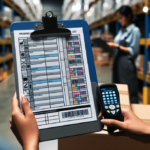Understanding the FedEx Delivery Process
Before delving into the specifics of the “in transit” phase, it’s essential to comprehend the overall FedEx delivery process. When you place an order with a retailer and select FedEx as your shipping method, the journey of your package begins with a FedEx driver picking it up from the retailer’s location.
The package is then transported to a local FedEx sorting facility, where it is categorized based on its destination and the selected delivery speed. From there, it moves through a network of distribution centers, utilizing ground or air transportation, depending on the service chosen. Once sorted onto the appropriate vehicle or aircraft, the package embarks on its journey toward your doorstep.
FedEx employs advanced tracking systems that allow customers to monitor their package’s progress in real-time via the FedEx website or mobile app. This transparency ensures you are informed about each stage of the delivery process, enhancing overall customer experience.
The 'In Transit' Phase Explained
What Does 'In Transit' Mean?
The “in transit” status indicates that your package is actively moving through the FedEx network toward its destination. This phase encompasses the journey from one sorting facility to another, whether by truck or airplane, and includes any necessary handling such as customs clearance for international shipments.
Duration of the 'In Transit' Phase
The time a package spends in transit can vary widely based on factors like shipping speed, distance, and external conditions. For example:
- FedEx Ground: Typically 1-5 business days within the contiguous United States.
- FedEx Express: Usually 1-3 business days for expedited services.
International shipments may take longer due to customs processing and longer transit distances.
Factors Affecting Transit Time
- Distance: Longer distances naturally increase transit times.
- Shipping Speed: Faster services reduce the time packages spend in transit.
- External Conditions: Weather events, natural disasters, and geopolitical factors can cause delays.
- Customs Clearance: International packages must pass through customs, which can add time.
According to FedEx’s 2023 Service Guide, they achieve an on-time delivery rate of approximately 97% for their express services, underscoring their reliability despite potential transit delays.
Tracking and Managing Your FedEx Package
Real-Time Tracking Features
FedEx provides robust tracking tools that allow you to monitor your package’s journey in real-time. By entering your tracking number on the FedEx Tracking page, you can view detailed status updates, including:
- Departure from the origin facility
- Arrival at transit hubs
- Customs clearance status for international shipments
- Out for delivery notifications
Managing Delivery Options
If you’re unavailable to receive your package, FedEx offers several options to manage delivery:
- FedEx Delivery Manager: Customize delivery times, request holds at FedEx locations, or provide specific delivery instructions.
- Reroute Packages: Change the delivery address mid-transit if necessary.
Utilizing these tools can enhance your delivery experience by providing greater control over when and where your package arrives.
Common Issues and Their Resolutions During 'In Transit'
Common Reasons for Delays
While FedEx strives for timely deliveries, several factors can cause packages to experience delays during the in-transit phase:
- Severe Weather: Storms, snow, and other weather events can disrupt transportation routes.
- Customs Delays: International shipments may face extended processing times if additional documentation is required.
- High Volume Periods: Holiday seasons and sales events can increase package volumes, potentially leading to delays.
- Incorrect Address Information: Errors in the destination address can result in rerouting or returned packages.
Resolving Transit Issues
If your package is delayed, here are steps you can take to resolve the issue:
- Contact FedEx Customer Service: Reach out to FedEx for detailed information and assistance with your package.
- Use FedEx Tracking: Check the latest status updates to identify where your package is held up.
- Verify Address Details: Ensure that the shipping address is correct to prevent misdelivery.
FedEx’s customer support is available 24/7 to help troubleshoot and resolve any issues that may arise during the transit process.
Tips for Faster and Safer Delivery
Choose the Right Shipping Speed
Selecting an appropriate shipping speed based on your delivery needs can significantly impact transit times. Opt for FedEx Express services if you require faster delivery, especially for time-sensitive or high-value items.
Ensure Accurate Shipping Information
Double-checking the shipping address and contact information minimizes the risk of delivery delays caused by misrouting or failed delivery attempts.
Use Delivery Confirmation Options
Options like signature confirmation or requiring a recipient’s signature upon delivery add an extra layer of security, ensuring that your package reaches the intended person and reducing the risk of theft.
Leverage FedEx Delivery Manager
Utilize FedEx’s delivery management tools to customize delivery preferences, schedule delivery times, and receive proactive notifications about your package’s status.
The Impact of Technology and Future Developments
Advanced Tracking and Route Optimization
FedEx employs sophisticated technology like GPS tracking and route optimization algorithms to enhance delivery efficiency. These technologies enable more accurate delivery estimates and allow for dynamic routing adjustments in response to traffic conditions or other unforeseen factors.
Automation and Robotics
Automation in sorting facilities and the use of robotics for package handling are increasingly integral to FedEx’s operations. These advancements improve processing speed and reduce the likelihood of human error, contributing to more reliable transit times.
Future Innovations
Looking ahead, FedEx is exploring innovations such as drone deliveries and autonomous vehicles to further streamline their delivery network. These technologies have the potential to revolutionize the logistics industry by reducing transit times and increasing delivery precision.
According to a 2023 report by the International Transport Forum, the integration of automation and artificial intelligence in logistics is expected to enhance delivery systems globally, making services like those offered by FedEx even more efficient and reliable.
Conclusion
The “in transit” phase is a critical component of the FedEx delivery process, encompassing the journey your package takes from origin to destination. Understanding this phase, along with leveraging FedEx’s tracking and management tools, can provide you with greater insight and control over your shipments.
While various factors can influence transit times, FedEx’s commitment to technological advancement and customer service ensures that packages are delivered safely and efficiently. By selecting the right shipping options and utilizing available resources, you can enhance your overall delivery experience.






















